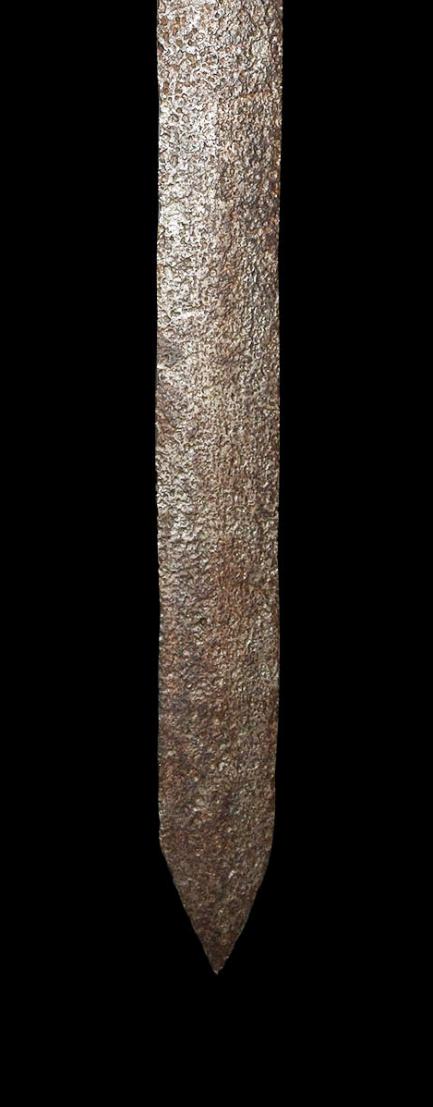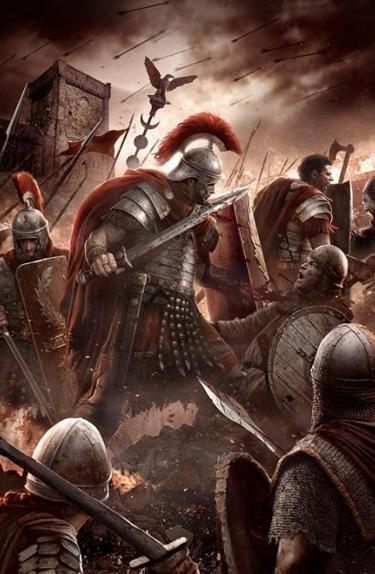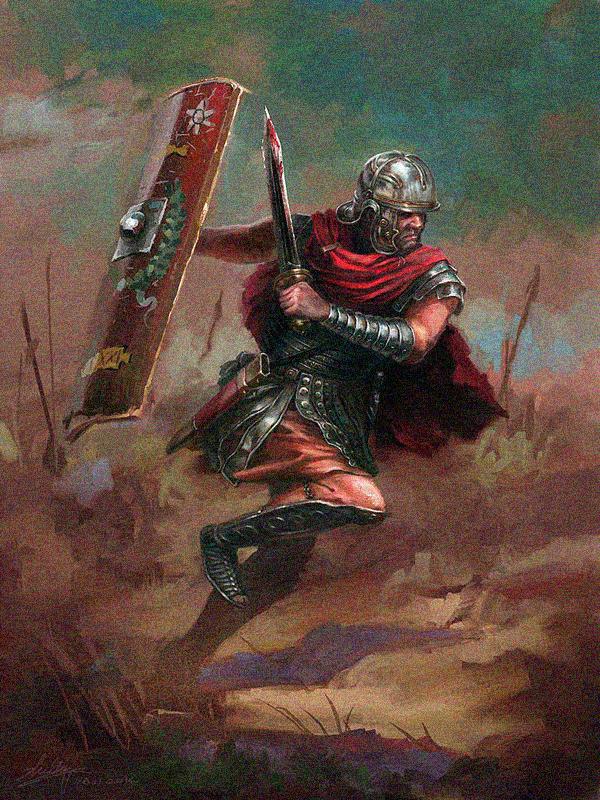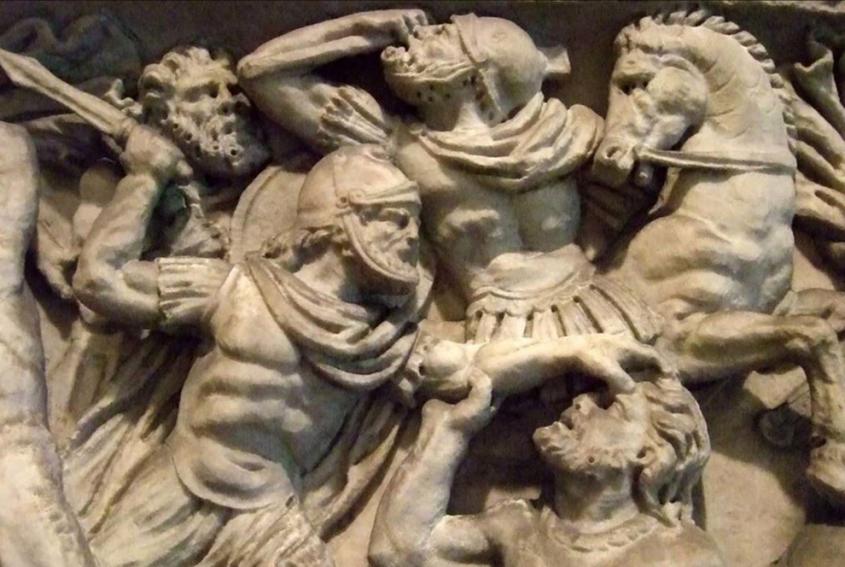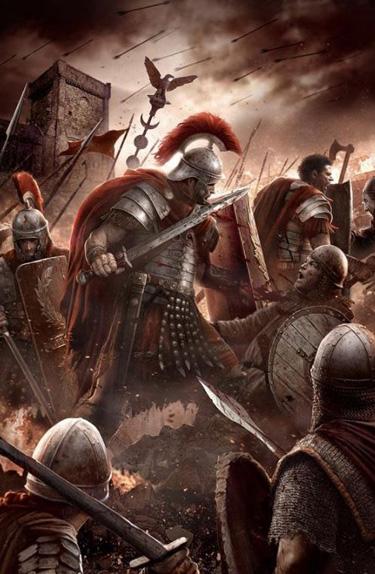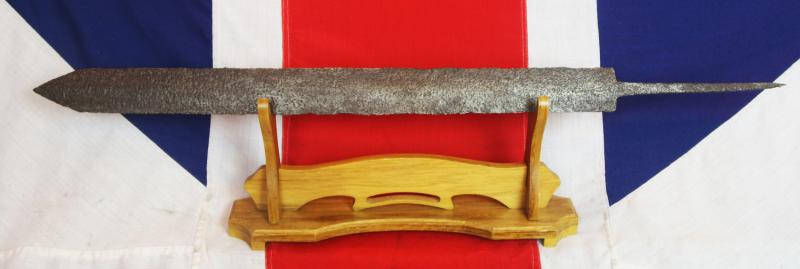Original, Imperial Roman Gladius, A Legionary's Sword, 1st Century, Almost 2000 Years Old. Made And Used During The Reigns in Imperial Rome of the Emperors, Augustus, Claudius, Tiberius, Caligula & Nero
A spectacular and rare beauty, as is typical just the blade remains intact. In the world of collecting early weaponry a sword is defined as it’s blade, its hilt was separate often made of vulnerable woods and organic materials that do not survive the ravages of time.
Only the second such original ancient Roman sword of its type that we have seen in the past ten years.
An absolute iconic sword, in fact, probably the most famous design of sword of antiquity. There is nothing that symbolises the age of Ancient Rome more than the legionary’s gladius. From the most famous empire that has ever existed, an empire that has had a greater influence in the development of modern civilisation than any other. There is barely a single part of today’s world that does not utilise the ancient creations, ideas, and developments of Ancient Rome. From the time of Imperial Rome and the Emperors, Augustus, Tiberius, Caligula, Claudius and Nero. Effectively from the golden age of Rome, the pinnacle of its power, the central 300 years of the 900 years of the rise and fall of the Roman Republic and Empire, and it’s dominance of the Western world, North Africa and the Middle East. A fabulous double-edged sword with the typology classification of ‘Pompeii’ type, with parallel cutting edges, sharply graduating towards the triangular point, with close combat sword-to-sword impact battle nicks to the edges, and a long tang. The ‘Pompeii’ gladius was named by modern historians after the Roman town of Pompeii. This type of gladius was by far the most popular used type of them all. Four instances of the sword type were found in Pompeii, with others turning up in other locations. Gladii were two-edged for cutting and had a tapered point for stabbing during thrusting. A solid grip was provided by a knobbed hilt added on, possibly with ridges for the fingers. The hilt/grips were of organic material, mostly wood, which simply never survives two millennia. Blade strength was achieved by welding together strips, in which case the sword had a channel down the centre, or by fashioning a single piece of high-carbon steel, rhomboidal in cross-section. The owner's name was often engraved or punched on the blade.
This kind of sword was much more suitable than the earlier Mainz typology for the fight against the Germanic tribes, allowing the legionary to deliver equally successful blows by stabbing and chopping. The specimen in question presents a very elongated blade and it is possible that it was used as weapon from horseback, representing a sort of transitional type between the short gladius and the long cavalry spatha. Similar long Pompeii blades specimens have been found in the Barbaricum and in a military camp of Germania Inferior. After Caesar's preliminary low-scale invasions of Britain, the Romans invaded in force in 43 AD, forcing their way inland through several battles against British tribes, including the Battle of the Medway, the Battle of the Thames, the Battle of Caer Caradoc and the Battle of Mona. Following a general uprising in which the Britons sacked Colchester, St Albans and London the Romans suppressed the rebellion in the Battle of Watling Street and went on to push as far north as central Scotland in the Battle of Mons Graupius. Tribes in modern-day Scotland and Northern England repeatedly rebelled against Roman rule and two military bases were established in Britannia to protect against rebellion and incursions from the north, from which Roman troops built and manned Hadrian's Wall
On the continent, the extension of the Empire's borders beyond the Rhine hung in the balance for some time, with the emperor Caligula apparently poised to invade Germania in 39 AD, and Cnaeus Domitius Corbulo crossing the Rhine in 47 AD and marching into the territory of the Frisii and Chauci. Caligula's successor, Claudius, ordered the suspension of further attacks across the Rhine, setting what was to become the permanent limit of the Empire's expansion in this direction.
Although at first sight they seem more similar to later spathae swords of the Roman army, they are examples of the great variety of weaponry existing inside the Armies of Rome, and of the way in which its structure was able to adapt itself to its various military needs. This sword type also present
a noteworthy problem in regards of precise individual dating, because without a precise archaeological context, there use can range from the 1st to the 3rd century AD (such as specimens from Windisch, Zwammerdam). For references on this sword type see; Curle, J., A Roman Frontier Post and its People, the Fort of Newstead in the Parish of Melrose, Glasgow, 1911; Bishop, M. C. & Coulston, J.C.N., Roman military equipment, from the Punic wars to the fall of Rome, London, 1993; Antonucci, C., ‘The Praetorians, the bodyguard of the Emperor Trajan, 2nd cent. AD’, in Ancient Warrior,1, Stockport, 1994, pp.3ff.; Feugère, M., Weapons of the Romans, Port Stroud, 2002; Bishop, M. C. & Coulston, J.C.N., Roman military equipment, from the Punic wars to the fall of Rome, London, 2006; Miks, C., Studien zur Romischen Schwertbewaffnung in der Kaiserzeit, I-II Banden, Rahden, 2007; for very similar specimens see Miks, 2007, n.A792 (Windisch, length 64 cm); A821 (Zwammerdam, length 71cm); A302 (Hofstade Steenberg, length 64cm); A369 (Korytnica, length 76.2cm); A354 (Klein-Winternheim, length 67cm).
In the world of collecting early weaponry a sword is defined as it’s blade, it’s hilt was separate often made of vulnerable woods and materials that do not survive the ravages of time. You simply do not often see such rare and iconic original ancient swords used by one of the most famed empires in the world, during the period of one of the greatest eras in classical history, let alone have the opportunity to own one. This sword is 855 grams, 84cm (33") including tang. Fine condition for age. Complete with a complimentary display stand
Code: 23516
11250.00 GBP


